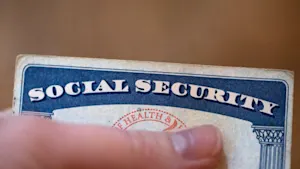Millennial Money: 4 expenses for parents to rethink in 2023
To help your money go further in 2023, you may want to reevaluate some of your recurring child-related expenses. Here are a few strategies for reducing costs, according to finance professionals.
Jan 17, 2023, 3:18 PM
•
Updated 1,018 days ago
Share:
More Stories
2:01

No progress: Frustrated Rockland businesses want more from lawmakers as pipeline project rankles revenue
2ds ago2:14

Tarrytown's Connor McGinn Studios shakes things up for the spooky season with 'The Creepshow'
2ds ago0:34

Amazon cuts 14,000 corporate jobs as spending on artificial intelligence accelerates
3ds ago1:46

The Cost Of: Halloween decorations & parties
4ds ago1:46

The Cost Of: Spooky season spending up for decorations and Halloween parties
4ds ago0:26

Social Security recipients get 2.8% cost-of-living boost in 2026, average of $56 per month
6ds ago2:01

No progress: Frustrated Rockland businesses want more from lawmakers as pipeline project rankles revenue
2ds ago2:14

Tarrytown's Connor McGinn Studios shakes things up for the spooky season with 'The Creepshow'
2ds ago0:34

Amazon cuts 14,000 corporate jobs as spending on artificial intelligence accelerates
3ds ago1:46

The Cost Of: Halloween decorations & parties
4ds ago1:46

The Cost Of: Spooky season spending up for decorations and Halloween parties
4ds ago0:26

Social Security recipients get 2.8% cost-of-living boost in 2026, average of $56 per month
6ds ago
When inflation rises, child care expenses do, too. If you’re a
parent, you may be hoping to get a little financial relief during the
upcoming tax season through deductions or credits. But since there have
been recent reductions to both of the child tax credits, you may not get
as much back as you anticipated.
If you’re like me, you could end
up paying the IRS instead of getting a refund from Uncle Sam. To help
your money go further in 2023, you may want to reevaluate some of your
recurring child-related expenses. Here are a few strategies for reducing
costs, according to finance professionals.
CHILD CARE
Many
of the increased tax credits and deductions parents enjoyed during the
height of the pandemic are reverting to their original limits. As a
result, parents should be prepared to get less back this year, says
Alton Bell II, principal accountant and founder at Bell Tax Accountants
& Advisors in Chicago.
“I would prepare for a tax refund
reduction shock because the credit around the dependent care has
significantly changed,” he says.
In 2021, the child and dependent
care credit increased to make child care more affordable for working
parents. It was raised to a maximum of $4,000 for one qualifying person
and $8,000 for two or more qualifying persons, and potentially
refundable. For 2022, the amount has gone back down to a maximum of
$1,050 for one qualifying person and $2,100 for two or more.
Additionally, the child tax credit is reverting to $2,000 for children
of all ages for the 2022 tax year. For 2021, it increased to $3,600 for
children under six and $3,000 for kids ages 6 to 17.
With these
cuts in mind, I thought it might be a good idea to ditch aftercare for
my 5-year-old son this year. My living room may look like the scene of a
volcanic eruption more often, but I’ll save $200 a month. If you work
remotely and can handle having your child home a few extra hours during
the day, consider giving this a test run.
Additionally, you could contribute to a dependent care flexible savings account,
which allows you to use pre-tax dollars to pay for child care. Bell
suggests maxing out that account for the year and also utilizing an
employer FSA match if your company offers one.
You can contribute $ 5,000 per household to a dependent care FSA in 2023, or $2,500 if you’re married filing separately.
GROCERIES
If
your snack cupboard is empty within three to five business days because
your kids have bottomless bellies, then you may be looking for ways to
reduce your grocery bill. This may especially be the case if you’re
feeling the effects of higher food costs due to inflation.
One
cost-saving strategy is to plan your shopping ahead of time to avoid
buying items you don’t need. Dominique Broadway, a personal finance
expert and founder of Finances Demystified in Miami, Florida, switched
from going to the store to using grocery delivery services so she knows
exactly how much she’ll spend.
Broadway also recommends putting
the same groceries in different delivery service provider carts so you
can do a side-by-side comparison of the price difference.
“You’ll
be surprised, the difference can be pretty large — sometimes 40, 50
bucks difference just because of delivery fees and the inflated prices.
Over time that actually does add up,” she says.
HEALTH CARE
Premiums
can become a noticeable expense when you pay them monthly. Adding
copays every time you visit the doctor increases your out-of-pocket
costs even more.
If you have a relatively healthy child and can
say the same for yourself, think about whether a health savings account
could save you money. HSAs can be used to pay health care expenses. The
limit for HSAs in 2023 is $3,850 for individuals and $7,750 for
families. The contributions are made with pre-tax dollars and are also
tax-deductible. You must have a high-deductible health insurance plan to
contribute to an HSA. High-deductible health plans sometimes have lower
premiums, which leads to some people saving money. Keep in mind that
with these plans, you may end up paying a higher deductible before your
insurance starts sharing health care costs with you.
I decided to
give it a test run in 2022. Since my son and I went to the doctor a
handful of times that year, my out-of-pocket costs came to just about
$700. The cherry on top is I had $1,500 left over thanks to my
employer’s contributions to my HSA account. I can now roll that money
over into the new year.
Millennial Money: Now is the time to build your credit
ENTERTAINMENT
There were so many
toys in my house by the end of 2022 that my son and I gave half away.
This year, I’m cutting costs by making better use of free activities.
Oftentimes, parents buy children items, only to realize what they really value is experiences, Broadway says.
“I’ve
purchased a $3 activity kit from Target and gotten hours of fun and
play with my children out of something like that versus just buying them
a bunch of toys,” she says. “I think that alone is a great way to cut
costs and build a better relationship with your children and make more
memories with them, as well.”
Speaking of experiences, there is a
trampoline park near our house that offers a $20 monthly subscription
for endless play. It seems more cost-effective to take my son there than
to buy more trucks and excavators I’ll end up tripping over.
If
any of these strategies lead to savings this year, Broadway suggests
investing the money in a custodial account for child-related future
expenses and to help your kids build wealth.
“Take that money and invest it for your children — have it working for you and for them.
More from News 12
1:33

The Real Deal: How to handle the New York housing market
1:42

The Real Deal: Calculating your commuting costs
1:20

Real Deal: Holiday spending means 2nd most expensive budget event of the year
1:24

The Real Deal: Shopping apps can help you cash in during holiday spending
1:28

Real Deal: Coffee, eggs, heat prices all rising in New York
1:08
